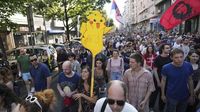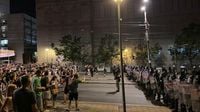For nearly a year, Serbia has witnessed a wave of student-led protests, a movement that has steadily grown in size and intensity as it challenges the government of President Aleksandar Vučić. What began as an outcry over a tragic accident has evolved into a broader anti-corruption campaign, drawing in thousands of citizens, sparking counter-mobilizations by government supporters, and, most recently, leading to violent confrontations between protesters and police across the country.
The catalyst for this unrest was the collapse of a concrete canopy at the main railway station in Novi Sad on November 1, 2024, which claimed the lives of 16 people. According to AP and Radio Free Europe, university students quickly organized, alleging that government negligence and corruption were to blame for the disaster. Their demands were clear: accountability for those responsible, systemic reforms, and, eventually, early parliamentary elections to restore public trust in institutions.
As the months passed, the movement gained momentum. By early September 2025, students had blocked more than 60 faculties across six state universities, with many campuses still shut down. Protests spread from Novi Sad to cities like Belgrade, Niš, Čačak, Šabac, and others, sometimes drawing thousands of participants. The students’ resolve was summed up in their call for action: “The authorities are bringing people to stage a choreographed picture of the ‘people’. They want to provoke incidents. Let us not fall for this show,” they urged, as reported by Radio Free Europe.
The government’s response has been twofold: a public call for dialogue and a show of force. President Vučić, who attended a government-support rally in Borča on September 7, insisted his invitation for talks remained open. “What does he want for his country, and what arguments does he have if he doesn’t dare to come out for dialogue, doesn’t dare to face a TV debate? If you are so convincing, if all the reasons are on your side, you’ll win easily. But it seems that’s not quite the case,” Vučić said, according to Radio Television of Serbia. Yet, student leaders have repeatedly rejected these overtures, stating they would only negotiate once early elections were called and their demands met.
Meanwhile, the ruling Serbian Progressive Party (SNS) has mobilized its own supporters. On September 3, SNS president Miloš Vučević called for rallies in 120 towns and cities, a move that saw more than 125,000 people take part in 111 “Citizens Against Blockades” events, according to police director Dragan Vasiljević. Parallel gatherings of government supporters and student protesters have led to tense stand-offs—most notably in Niš, Čačak, and Šabac. In these cities, police often intervened, forming cordons to separate rival groups and, in some cases, using force to disperse crowds.
The violence reached a peak on September 5 in Novi Sad, where police deployed batons, armored vehicles, tear gas, and stun grenades to break up a demonstration at the university campus. According to AP, dozens were injured as riot police charged at protesters, sending many fleeing in panic. Police justified their actions by citing “massive attacks” from masked demonstrators who allegedly threw flares and objects at officers. But student organizers painted a different picture, accusing police of “brutal attacks on their own citizens.”
Allegations of police brutality have become a rallying cry. At a rally in downtown Belgrade on September 8, thousands chanted slogans against President Vučić and demanded the punishment of officers responsible for excessive force. Among the most harrowing accounts was that of Nikolina Sindjelic, a student detained during the August protests. “They (government) beat us because they are afraid of us,” she declared, as reported by AP. She further accused a special police unit commander of making rape threats during her detention, stating, “They have hit us and they will hit us because they know it is all over (for them).” The crowd responded with chants of “He is Finished,” a direct jab at the president’s embattled rule.
The government, for its part, has escalated its crackdown. President Vučić has dismissed professors and teachers, deployed police inside faculty buildings, and accused the students of “terrorism” and acting under Western orders—allegations he has not substantiated. An elite police unit commander claimed he was forced to retire due to purges targeting officers not deemed loyal to Vučić. These actions have drawn concern from the European Union, with European Commissioner for Enlargement Marta Kos stating, “The people have the right to protest. The severe violence on the streets of Serbia, the many acts of vandalism must stop. We expect the police to act appropriately and respect fundamental rights.”
Despite the mounting pressure, President Vučić has refused to call early elections, insisting that the students’ demands have already been met. This stance has only fueled further anger among protesters, who see it as a refusal to accept responsibility or enact meaningful change. The government’s supporters, meanwhile, argue that the protests are disruptive and even dangerous, pointing to incidents in mid-August when SNS loyalists threw pyrotechnics at demonstrators and, in response, student-citizen gatherings vandalized party offices.
As the standoff continues, the streets of Serbia remain a battleground—sometimes literally, as seen in the recent clashes in Novi Sad, Čačak, and Šabac. Police director Dragan Vasiljević has repeatedly emphasized the scale and orderliness of government rallies, stating that “all gatherings passed without incident,” except for a few isolated confrontations. Yet, footage and eyewitness reports suggest a more complicated reality, with aggressive police behavior and a tense atmosphere hanging over each demonstration.
Underlying all of this is Serbia’s complex political landscape. The country is formally seeking membership in the European Union, but under Vučić’s leadership, it has maintained close ties with Russia and China and faced persistent accusations of stifling democratic freedoms, including the suppression of free media. The protests have become a focal point for these broader anxieties, as students and citizens alike demand a more transparent and accountable government.
For now, the impasse remains. Students have urged citizens to stay off the streets during government rallies to avoid provoked incidents, while government supporters continue to mobilize in large numbers. The memory of the Novi Sad tragedy, and the question of who bears responsibility, continues to drive the protests—and the sense that something fundamental is at stake in Serbia’s political future lingers in the air.


